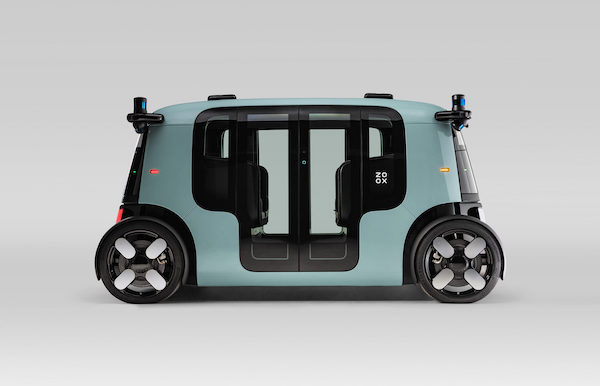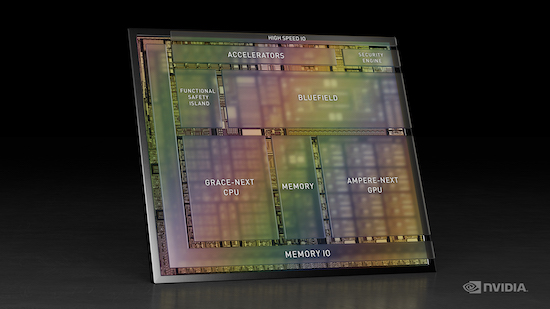New NVIDIA Processor for Autonomous Vehicles
NVIDIA DRIVE Atlan is an AI-enabled system on a chip.

Robotaxi companies like Zoox are leveraging the NVIDIA DRIVE platform. Image courtesy of NVIDIA.
Latest News
April 20, 2021
NVIDIA announced its next-generation AI-enabled processor for autonomous vehicles, NVIDIA DRIVE Atlan, which the company says will deliver more than 1,000 trillion operations per second (TOPS) and targets automakers’ 2025 models.
DRIVE Atlan will include NVIDIA’s next-generation GPU architecture, new Arm CPU cores, as well as deep learning and computer vision accelerators. The company says this data-center-like performance will provide automakers with sufficient compute capabilities to build software-defined vehicles that are richly programmable and perpetually upgradeable through secure, over-the-air updates.

“The transportation industry needs a computing platform that it can rely on for decades. The software investment is too immense to repeat for each car. NVIDIA DRIVE is the most advanced AI and AV computing platform, with rich global software and developer ecosystems, and architecturally compatible for generations,” said Jensen Huang, founder and CEO of NVIDIA. “Today, we are announcing the next extension of our roadmap — our new DRIVE Atlan is truly a technical marvel, fusing all of NVIDIA’s strengths in AI, auto, robotics, safety and BlueField-secure data centers to deliver safe, autonomous-driving fleets.”
DRIVE Atlan will integrate an NVIDIA BlueField data processing unit (DPU), which supports complex compute and AI workloads found in autonomous vehicles. BlueField offers full data-center-infrastructure-on-a-chip programmability, armed with a safe security enclave to prevent data breaches and cyberattacks. According to NVIDIA, DRIVE Atlan is designed to handle the large number of AI applications that run simultaneously in autonomous machines, safely and securely.
The company’s original processor for autonomous driving, NVIDIA DRIVE Xavier (30 TOPS) is currently used in production cars and trucks, while NVIDIA DRIVE Orin (254 TOPS) has been selected by several automakers for production timelines starting in 2022. According to the company, NVIDIA DRIVE Atlan will extend the NVIDIA DRIVE family of SoCs’ leadership for vehicles’ 2025 production targets and beyond.
At the GTC conference last week, NVIDIA also announced that Volvo, Zoox and SAIC are using the NVIDIA DRIVE platform in their autonomous vehicle projects.
“Transportation is becoming a technology industry. Besides having amazing autonomous driving and AI technologies, vehicles will be programmable platforms to offer software-driven services. The business models of transportation will be reinvented,” Huang said. “Our design wins demonstrate how NVIDIA is partnering with one of the world’s largest and most impactful industries to help revolutionize the future of mobility.”
Volvo Cars announced that it will build its next-generation models on NVIDIA DRIVE Orin. The first car featuring DRIVE Orin technology, the next-generation Volvo XC90, is planned to be revealed next year.

NVIDIA DRIVE Orin will be combined with software developed in-house by Volvo Cars and Zenseact (Volvo Cars’ autonomous driving software development company), an advanced sensor suite that includes lidar as well as steering and braking backup systems.
Zoox recently unveiled its purpose-built robotaxi designed for everyday urban mobility. The vehicle is powered by NVIDIA DRIVE and is one of the first robotaxis featuring bi-directional capabilities, the company says.
DiDi, China’s leading mobility-as-a-service provider, has also announced it is adopting NVIDIA DRIVE for its entire autonomous driving test fleet. These robotaxi companies join others already developing on the NVIDIA DRIVE platform, including Pony.ai and Auto X.
Additionally, a growing number of automotive startups and EV brands have in recent months announced plans to build software-defined vehicles using NVIDIA DRIVE Orin to deliver continuously improving AI capabilities, beginning as early as next year. They include:
SAIC, China’s largest automaker, which is readying two new EV brands packed with advanced AI features. The R Auto family of next-gen vehicles will feature the R-Tech advanced intelligent assistant, powered by NVIDIA DRIVE Orin, to run perception, sensor fusion and prediction for automated driving features in real time. Its ultra-premium IM brand — a joint venture with Alibaba — will deliver long-range EVs powered by NVIDIA DRIVE Orin, including a sedan and SUV with autonomous parking and other automated driving features. Orders are starting now for the sedan, with the SUV following in 2022.
Faraday Future, a global intelligent mobility company, which is using NVIDIA DRIVE Orin in its flagship ultra-luxury FF 91 EV to achieve advanced highway autonomous driving capabilities and advanced parking and summon features when it goes on sale in 2022. Its next-generation FF 71 and FF 81 vehicles, which will be available in 2023 and 2024, respectively, will also be powered by NVIDIA DRIVE Orin.
Vietnam’s leading automaker, VinFast, which is starting mass production of its VF e34, VF e35 and VF e36 intelligent EVs with level 2-3 autonomous capabilities. It plans to upgrade these premium EV models from NVIDIA DRIVE Xavier™ to NVIDIA DRIVE Orin.
Nio, which has announced that its ET7 sedan will offer advanced automated driving capabilities featuring a supercomputer, dubbed Adam, powered by four NVIDIA DRIVE Orin SoCs totaling 1,000 TOPS. The ET7 will start to ship in China in 2022.
Li Auto, which is developing next-gen EVs using NVIDIA DRIVE Orin with plans to ship in 2022. The China carmaker’s new EVs are being developed in collaboration with tier-1 supplier Desay SV and feature advanced autonomous driving features and an extended battery range.
Xpeng, which is already putting its advanced driving technology on the road with the P7 sedan. Last month, the automaker completed a record-setting, six-day cross-country autonomous drive with a fleet of P7 vehicles powered by NVIDIA DRIVE Xavier. Xpeng plans to upgrade to NVIDIA DRIVE Orin in 2022.
In the trucking industry, Navistar is partnering with TuSimple to build self-driving trucks designed for level 4 autonomous operation, powered by NVIDIA DRIVE. The U.S. maker’s intelligent trucks are targeted for production by 2024.
China’s largest truck maker, FAW, is working with Plus to develop autonomous trucks on the NVIDIA DRIVE platform. These trucks will start production later this year and will upgrade to Orin in 2022.
Volvo Autonomous Solutions, part of Volvo Group, is also using the end-to-end NVIDIA DRIVE platform for the development of autonomous transport solutions and next-generation level 4 trucks.
More NVIDIA Coverage
Subscribe to our FREE magazine, FREE email newsletters or both!
Latest News
About the Author
DE’s editors contribute news and new product announcements to Digital Engineering.
Press releases may be sent to them via [email protected].





